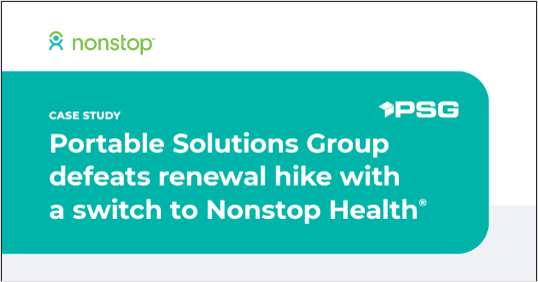The opioid crisis in America has received significant attention the past few months. Multiple government and medical professional societies have issued new guidelines; 37 state attorneys general sent a letter to the nation’s health plan association encouraging health plans to evaluate coverage policy for non-pharmacologic solutions for pain management; states announced new guidelines on opioid prescribing; and the president declared a public health emergency relating to the opioid crisis.
And while it’s important and appropriate for the health care industry and lawmakers to initiate a rapid and definitive response to opioid overuse and abuse, it’s also important not to get distracted from the root cause: We have a pain management crisis in the United States. One hundred sixteen million Americans suffer from chronic pain, and a recent article in the Journal of the American Medical Association reported that estimated direct health care costs for musculoskeletal conditions, including pain of the spine, neck, hip, shoulder, knee, wrist, and elbow, among others, have escalated to an alarming $183.5 billion annually. These conditions are more expensive than cancer care ($115.3B) and cardiac disease care ($175.1B).
Some important causes of these excessive pain care expenditures, as identified by the Institute of Medicine report “Relieving Pain in America,” include:
-
imprecise diagnostic evaluation and treatment planning
-
low utilization rates of non-invasive, non-pharmacologic, evidence-based approaches as a first-line pain treatment
-
overuse and poor management of pharmaceutical interventions
-
excessive selection of patients for invasive, surgical treatments, and poor post-surgical support
-
poor coordination of care and lack of comprehensive interdisciplinary approach
-
inadequate attention to the bio-psycho-social aspects of pain that can impact ability to improve function.
As states and federal officials band together to change prescribing practices of opioid pain medications, physicians, insurers, advisors and employers must step up to offer access to affordable and evidence-based options that can help employees in pain, and also mitigate the costs of unsuccessful treatment, lost time from work, and low productivity at the job.
Here are five options that brokers and benefits administrators should consider when determining a strategy to deal with pain in the workplace.
1. Assessment and education
If you haven’t done a thorough assessment of the impact of pain in your workplace, here’s a good place to start. Knowing whether pain impacts 10 percent or 80 percent of your employee population will help you determine the breadth and depth of the pain management program you need to establish. Administrators can evaluate benefit plan claims data to assess costs for pain-related treatments, and use surveys (e.g., health assessment surveys; presenteeism surveys) to poll the employee population and better understand how many employees are impacted by frequent or chronic pain. Survey results can be the basis for determining the level of education, new program implementation, and outreach that your organization needs to establish. Evidence-based pain education modules can be deployed via your company web portal or newsletter, in combination with posters, fliers and other communications to steer employees to your pain education campaign.
2. Self-care options
For those employees with low levels of acute or chronic pain, and high levels of motivation and activation, self-care options such as mindful movement, relaxation training, exercise, and education about posture and body mechanics can be very effective in helping to mitigate pain and/or prevent re-injury. Employees can be educated on how to effectively engage with their physician or other practitioner to:
-
understand the specific causes of their pain
-
identify barriers to movement and how to move safely
-
safely implement self-care
-
recognize early warning signs of potential flare-up or re-injury
-
understand medications and the appropriate application of self-care treatments, such as heat versus ice
-
practice mental imagery and stress management techniques.
Employee education and self-care training should always be considered the first lines of treatment in any pain management strategy. Employees need reliable and easily available information to make better decisions about how they treat painful conditions.
3. Conservative therapies
For workplaces with a higher percentage of employees suffering from acute and chronic pain conditions, there are many additional, effective care options. These include options such as physical therapy, manual therapy, massage therapy, and acupuncture. Recent systematic reviews and guidelines about the effectiveness of physical therapy/rehabilitation, spinal manipulation, acupuncture, and therapeutic massage for managing musculoskeletal back pain have been published by the Agency for Healthcare Research and Quality (AHRQ), the American College of Physicians (ACP), and others. Patients find that these therapies can often resolve their pain, or reduce it to a manageable level. Additional good news for benefits administrators is that many health plans and specialty benefits administrators offer affordable, employer-sponsored coverage for these therapies.
4. Cognitive behavioral training
As it turns out, psychological factors (such as depression and anxiety), maladaptive coping strategies (such as fear avoidance or catastrophizing), and other psychosocial issues can have a tremendous impact on functional impairment in pain patients. So benefits administrators need to consider pain interventions that include the use of cognitive behavioral training (CBT), with the goal of changing patterns of thinking or behavior related to perceptions about pain. CBT does this by focusing on a person’s cognitive processes (the thoughts, images, beliefs and attitudes). CBT is beneficial for improving symptoms and functioning in adults with chronic musculoskeletal pain. Significant results include improvements in pain severity, pain-related interference, pain-related disability, catastrophizing, and mood. CBT has also been shown to result in fewer days of work missed due to pain-related disability. CBT should be established with definitive goals, including transitioning the employee to self-care, mindful movement and exercise programs.
Pain management programs that include CBT techniques provide a useful tool in their product offerings. CBT can prove to be a cost-effective way of helping employees return to work as happier, more productive employees.
5. A comprehensive pain management program
As noted earlier, one of the key drivers behind the excessive costs of musculoskeletal pain programs has been poor coordination of care and lack of a comprehensive interdisciplinary approach to pain management. By and large, pain has been managed in specific silos of care, with desperate patients drifting from one silo to the next, hoping for a different result with each new type of care. Comprehensive pain management interventions offered at the workplace may provide better outcomes when education, self-care, physical exercise, cognitive behavioral interventions, and evidence-based provider-delivered services are available, including non-invasive, non-pharmacologic pain solutions.
Comprehensive and coordinated pain management programs are intended to provide a structured ecosystem that surrounds the employee with coordinated care options and educates the employee about how and when to choose different levels of effective interventions. A coordinated system should provide individualized education and tailored action steps to meet the complex needs of each person.
The goal of an effective pain management program is empowering and activating individuals toward improved decision-making, enhanced self-management behaviors, and more effective self-care that can improve pain control and functional capacity. The value of having a coordinated and comprehensive approach to pain care should not be underestimated. Offering up the right tools at the right time can help your affected workforce population emotionally, intellectually and physically.
Given the high prevalence of painful health conditions and the risks associated with opioid use, providing safe and effective pain management options to reduce the need for opioid medications and invasive interventions is a critical next step. Depending on the impact of pain in your clients’ workforces, one of these strategies, or a comprehensive program that includes them all, can make a difference for employees and your clients’ bottom lines. Benefits administrators should reach out to their benefits advisors and/or health insurance providers to learn more about their options in providing employee access to non-invasive, non-pharmacologic pain solutions.
Complete your profile to continue reading and get FREE access to BenefitsPRO, part of your ALM digital membership.
Your access to unlimited BenefitsPRO content isn’t changing.
Once you are an ALM digital member, you’ll receive:
- Breaking benefits news and analysis, on-site and via our newsletters and custom alerts
- Educational webcasts, white papers, and ebooks from industry thought leaders
- Critical converage of the property casualty insurance and financial advisory markets on our other ALM sites, PropertyCasualty360 and ThinkAdvisor
Already have an account? Sign In Now
© 2024 ALM Global, LLC, All Rights Reserved. Request academic re-use from www.copyright.com. All other uses, submit a request to [email protected]. For more information visit Asset & Logo Licensing.








